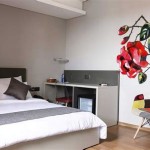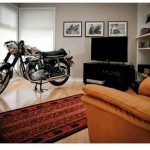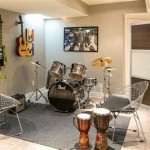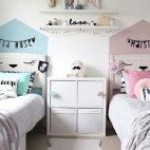```html
How To Decorate a Dead Corner
Dead corners, often found in homes and offices, are those awkward spaces that seem to defy purpose. They can be areas where walls converge at unusual angles, the space behind a door swing, or simply the neglected area at the end of a hallway. Leaving these corners bare makes a room feel unfinished and can impact the overall flow and aesthetic appeal. Transforming these spaces, however, can add depth, personality, and functionality to any room. Effective corner decoration involves careful consideration of the room's style, available space, lighting, and intended purpose. The aim is to convert a neglected space into a highlight that complements the overall design.
Before embarking on any decoration project, assessing the corner space is crucial. This involves measuring the dimensions of the corner, noting any architectural peculiarities like protruding pipes or electrical outlets, and observing the natural lighting. Consideration must also be given to the existing décor of the room. The corner design should integrate seamlessly with the rest of the space, maintaining a consistent style and color palette. Furthermore, consider the function the corner could potentially serve. Is it to be purely decorative, or can it be used for storage, seating, or another practical purpose?
Optimizing Vertical Space
One of the most effective ways to decorate a dead corner is to utilize vertical space. This approach is particularly useful in small rooms where floor space is limited. Vertical solutions draw the eye upwards, creating an illusion of height and making the room feel more spacious. Several options are available for optimizing vertical space in a dead corner.
Tall shelving units are a classic and versatile choice. They provide ample storage and display space. Open shelving allows for showcasing decorative items, books, plants, or artwork. Closed shelving, on the other hand, can be used to conceal clutter and store less visually appealing items. The style of the shelving unit should complement the existing décor. For a modern aesthetic, consider sleek, minimalist shelves in neutral colors. For a more traditional look, opt for wooden shelves with ornate detailing. When selecting a shelving unit, ensure it is sturdy and stable, particularly if it will be used to store heavy items. Wall-mounted shelves are also a good option, especially in small spaces, as they do not take up any floor space.
Another effective solution is a tall plant stand. Plants bring life and vibrancy to any room, and a tall plant stand can transform a lifeless corner into a focal point. Select a plant species that thrives in the available light conditions. Large, leafy plants like snake plants, fiddle-leaf figs, or monstera are visually striking and can make a significant impact. Alternatively, a collection of smaller potted plants can be arranged on a multi-tiered plant stand. This creates a miniature indoor garden and adds a touch of natural beauty to the space.
Vertical artwork is another way to draw the eye upwards and add personality to a dead corner. A large, impactful painting or a gallery wall of smaller prints can transform the space. When selecting artwork, consider the color palette and style of the room. Choose pieces that complement the existing décor and reflect personal taste. Hanging the artwork at eye level ensures that it is easily viewed and appreciated.
Leaning mirrors are a sophisticated option for smaller corners. A tall mirror propped against the wall not only adds visual interest but also creates the illusion of more space by reflecting light and expanding the room's perceived dimensions. Look for mirrors with decorative frames to add a touch of elegance and style.
Maximizing Functionality
Dead corners can be more than just decorative features; they can also serve a practical purpose. By strategically incorporating functional elements, these spaces can be transformed into valuable additions to the room. Maximizing functionality in a dead corner involves careful consideration of the room's needs and the available space.
Creating a reading nook is a popular and practical option. All that is required is a comfortable armchair or loveseat, a small side table, and adequate lighting. The armchair should be positioned to take advantage of natural light if possible. A floor lamp or table lamp provides additional illumination for reading. The side table can be used to hold books, drinks, or other essentials. Adding a soft throw blanket and a few decorative pillows enhances the comfort and coziness of the reading nook. This transforms the dead corner into a relaxing and inviting space for reading and relaxation.
A small home office can also be created in a dead corner. This is particularly useful in apartments or homes where dedicated office space is limited. A compact desk, a comfortable chair, and adequate lighting are essential. The desk should be sized appropriately for the available space, and ergonomic considerations should be prioritized when selecting a chair. A desk lamp or task lighting provides focused illumination for working. Shelves or drawers can be added to the desk or wall to provide storage for office supplies. This transforms the dead corner into a functional workspace.
A storage solution can be implemented to address organizational needs. Corner shelves, cabinets, or baskets can be used to store items that would otherwise clutter the room. Corner shelves are particularly effective for utilizing the awkward angles of the corner. Cabinets provide concealed storage for items that need to be kept out of sight. Baskets can be used to store smaller items, such as blankets, toys, or magazines. The style of the storage solution should complement the existing décor of the room.
A bar cart can be a stylish and functional addition to a dead corner in a living room or dining room. A bar cart provides a convenient place to store and display drinks, glassware, and bar accessories. It can also be used as a serving station when entertaining guests. Choose a bar cart that complements the style of the room and consider the available space when selecting the size. Some bar carts have wheels, making them easy to move around as needed.
Enhancing Ambiance and Style
Beyond functionality, decorating a dead corner provides an opportunity to enhance the overall ambiance and style of a room. The goal is to create a visually appealing space that complements the existing décor and adds personality to the room. This involves careful consideration of color, texture, lighting, and decorative accessories.
Strategic lighting can dramatically transform a dead corner. A well-placed lamp can illuminate the space and create a warm and inviting atmosphere. Floor lamps are a versatile option, providing ambient lighting and adding height to the corner. Table lamps can be placed on shelves or side tables to provide task lighting or accent lighting. String lights or fairy lights can be used to create a whimsical and romantic ambiance. Consider the light temperature and brightness when selecting lighting fixtures. Warm light creates a cozy atmosphere, while cool light provides brighter, more focused illumination.
Adding decorative accessories enhances the visual appeal of the corner. Vases, sculptures, candles, and picture frames can be used to personalize the space and reflect personal taste. Choose accessories that complement the color palette and style of the room. Arrange the accessories in a visually appealing manner, varying the heights and textures to create interest. Avoid overcrowding the corner with too many accessories; less is often more.
Rugs can be used to define the corner space and add warmth and texture to the room. A small area rug placed in the corner can visually delineate the space and make it feel more inviting. Choose a rug that complements the color palette and style of the room. Consider the size and shape of the rug in relation to the corner space. A round rug can be particularly effective in softening the angles of a corner.
The use of color significantly impacts the overall look and feel of the corner. A pop of color can add visual interest and draw the eye to the space. Consider painting the corner wall a different color than the rest of the room. Alternatively, use colorful accessories, such as pillows, throws, or artwork, to add pops of color. Be mindful of the color palette of the room and choose colors that complement the existing décor.
```
10 Clever Ways To Style Dead Corners

Corner Decoration With Framing Portfolio Framers

Corner Shelves A Smart Small Space Solution All Over The House Interior Home Decor Inspiration Living Room

10 Clever Ways To Style Dead Corners

10 Clever Ways To Style Dead Corners

Fun And Fabulous Ways To Decorate Empty Corners The Cottage Market

30 Stylish Corner Decoration Ideas How To Decorate A

10 Clever Ways To Style Dead Corners

Ideas For Decorating A Dead Corner Behind Sectional With Mirror Hometalk

25 Ways To Decorate Little Corners Remodelando La Casa
Related Posts







